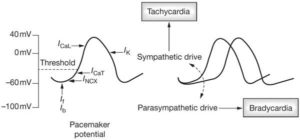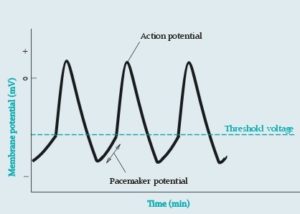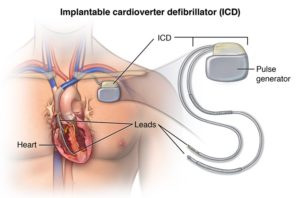What Pacemaker actually is ?
A pacemaker is a small device that’s placed in the chest or abdomen to help control abnormal heart rhythms. This device uses low-energy electrical pulses to prompt the heart to beat at a normal rate.
Pacemakers are used to treat arrhythmias. Arrhythmias are problems with the rate or rhythm of the heartbeat. During an arrhythmia, the heart can beat too fast, too slow, or with an irregular rhythm. Pacemakers can relieve some arrhythmia symptoms, such as fatigue (tiredness) and fainting. A pacemaker also can help a person who has abnormal heart rhythms resume a more active lifestyle.
The generator is the battery but it is also the “brains” of the pacemaker. The leads hook into the generator after they are placed into the heart muscle. There are several types and sizes of leads and the cardiologists who place the pacemaker typically choose which leads to use. It may depend on the size of the veins, size of the heart, costs etc. Some people have only one lead, but more commonly there are two leads. One lead usually goes into the top part of the heart called the atrium. The second lead goes into the bottom chamber of the heart called the ventricle. A third lead may be placed into the left ventricle or coronary sinus in individuals that have heart failure or have had an AV node ablation.
What Pacemaker does ?

Pacemakers generally treat two types of arrhythmias:
- tachycardia, or a heartbeat that’s too fast
- bradycardia, or a heartbeat that’s too slow
There are also special types of pacemakers called biventricular pacemakers, or bivents. A person may need one of these pacemakers if they have severe heart failure. They make the two sides of the heart beat in sync. This is also known as cardiac resynchronization therapy (CRT).
Doctors also treat arrhythmias with implantable cardioverter defibrillators (ICDs). ICDs are similar to pacemakers. However, besides using low-energy electrical pulses to control abnormal heart rhythms, ICDs also can use high-energy electrical pulses to treat certain dangerous arrhythmias.
Different types of Pacemakers :
There are now many different types of pacemakers which assist in treating other heart conditions as well such as combining pacemakers and defibrillators in one device. Some devices only use one electrode while others make use of many electrodes to regulate different positions of the heart.
The three basic types of implantable pacemakers which use permanent pacing include:
- Single-chamber pacemakers, this type of pacemaker only uses one pacing lead. The pacing lead is placed in only one chamber, either the atrium or the ventricle.
- Dual-chamber pacemakers, this type of pacemaker uses two pacing leads. The pacing leads are placed in two chambers of the heart, with one pacing the ventricle and the other pacing the atrium.
- Rate-responsive pacemakers, this type of pacemaker includes a sensor that automatically adjusts due to a change in the activity of the human body.
How are pacemakers fitted ?

Pacemakers are fitted under a local anesthetic with sedation, so you’ll feel very sleepy. After the pacemaker is fitted, you’ll usually stay overnight in the hospital and your pacemaker will be checked thoroughly before you leave. Serious complications from pacemakers are very unusual.
Necessity of Pacemaker :
You need a pacemaker if your heart is pumping too quickly or slowly. In either case, the body doesn’t get enough blood. This can cause:
- fatigue
- fainting or light-headedness
- shortness of breath
- damage to vital organs
- eventual death
Doctors recommend pacemakers for a number of reasons. The most common reasons are bradycardia and heart block. Bradycardia is a slower than normal heartbeat. Heart block is a problem that occurs with the heart’s electrical system. The disorder occurs when an electrical signal is slowed or disrupted as it moves through the heart.
Before recommending a pacemaker, your doctor will consider any arrhythmia symptoms you have, such as dizziness, unexplained fainting, or shortness of breath. He or she also will consider whether you have a history of heart disease, what medicines you’re currently taking, and the results of heart tests.
How to prepare a Pacemaker ?
A pacemaker consists of a battery, a computerized generator, and wires with sensors called electrodes on one end. The electrodes detect your heart’s electrical activity and send data through the wires to the computer in the generator.
If your heart rhythm is abnormal, the computer will direct the generator to send electrical pulses to your heart. The pulses then travel through the wires to reach your heart. Newer pacemakers also can monitor your blood temperature, breathing, and other factors and adjust your heart rate to changes in your activity.
Placing a pacemaker requires minor surgery. The surgery usually is done in a hospital or special heart treatment laboratory. You’ll be given medicine just before the surgery that will help you relax and may make you sleepy.
The surgery takes just a few hours, but you’ll stay in the hospital overnight so your health care team can check your heartbeat and make sure your pacemaker is working properly.
Implanting a Pacemaker :

The procedure to implant a pacemaker is usually quick. It does not require open-heart surgery, and most people go home within 24 hours. Before the surgery, medication is usually given to make you sleepy and comfortable. The procedure can be performed under local or general anesthesia.
- A small incision, approximately 5 centimeters long will be made in the upper chest
- One or two leads (thin insulated wires) will be guided through a vein into the heart
- The doctor will then connect the lead(s) to your pacemaker and program the device for your medical needs
- Then the pacemaker will be inserted beneath your skin, and the incision in your chest will be closed
- Your doctor will test the pacemaker to ensure it is working properly to meet your medical needs.
Complications related to Pacemaker :
- an allergic reaction to anaesthesia
- bleeding
- bruising
- damaged nerves or blood vessels
- an infection at the site of the incision
- a collapsed lung, which is rare
- a punctured heart, which is also rare
Most complications are temporary. Life-altering complications are rare. Complications from pacemaker surgery are rare. Most people can return to their normal activities within a few days.
Things should be avoided after surgery :
Certain devices could cause interference with your pacemaker. For example, you should avoid:
- keeping a cell phone or MP3 player in the pocket over your pacemaker
- standing for too long near certain appliances, such as microwaves
- long exposures to metal detectors
- high-voltage transformers
Your doctor may ask you to avoid vigorous exercise or heavy lifting for about a month after your surgery. After you have fully recovered from surgery, discuss with your doctor how much and what kinds of physical activity are safe for you.
Once you have a pacemaker, you have to avoid close or prolonged contact with electrical devices or devices that have strong magnetic fields. You also need to avoid certain medical procedures that can disrupt your pacemaker.
Pacemaker batteries last between 5 and 15 years (average 6 to 7 years), depending on how active your pacemaker is. The wires of your pacemaker also may need to be replaced eventually. Your doctor can tell you whether your pacemaker or its wires need to be replaced.
Pacemaker Implant prevent Heart Attack :
True myocardial infarction (classic heart attack) is a result of blockage of coronary artery blood flow, unrelated to a rhythm disorder or to the pacemaker which may correct it. However, one consequence of infarction (which may occur in other circumstances as well) can be ventricular fibrillation, a non-rhythmic and non-pumping state which is fatal if untreated. While a standard pacemaker lacks the electrical power to reset the heart’s normal rhythm, a device called an “automated implantable cardioverter-defibrillator” can—essentially providing an internal “shock” to restart the heart, just as paramedics (and civilians) can do with an external defibrillator. While not preventing a myocardial infarction, an AICD can prevent death from ventricular fibrillation from any cause.
Problems with a Pacemaker :
A pacemaker can go wrong if:
- The lead gets pulled out of position.
- The battery of the pulse generator fails.
- The circuits that control the pacemaker are damaged after being exposed to strong magnetic fields.
- The pacemaker hasn’t been properly programmed.
You will see your specialist for follow-ups on a regular basis for adjustments and a battery check.
A regular schedule of checkups will help your pacemaker last longer.
